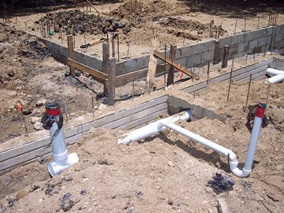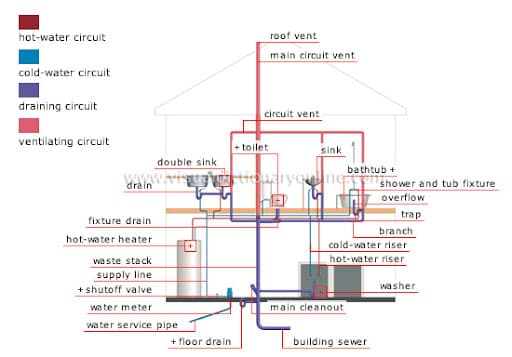Exploring The Layout of Your House's Plumbing System
Exploring The Layout of Your House's Plumbing System
Blog Article
Any individual maintains their own unique piece of advice about Plumbing Installation 101: All You Need to Know.

Recognizing just how your home's plumbing system works is essential for each house owner. From delivering tidy water for alcohol consumption, food preparation, and bathing to safely removing wastewater, a properly maintained plumbing system is important for your household's wellness and comfort. In this thorough guide, we'll check out the complex network that makes up your home's pipes and deal suggestions on maintenance, upgrades, and taking care of common issues.
Introduction
Your home's pipes system is greater than just a network of pipes; it's a complex system that ensures you have accessibility to tidy water and efficient wastewater removal. Understanding its parts and just how they interact can aid you prevent pricey repairs and make certain whatever runs smoothly.
Fundamental Components of a Plumbing System
Pipes and Tubing
At the heart of your plumbing system are the pipes and tubes that bring water throughout your home. These can be made from various materials such as copper, PVC, or PEX, each with its advantages in regards to sturdiness and cost-effectiveness.
Fixtures: Sinks, Toilets, Showers, etc.
Components like sinks, commodes, showers, and bathtubs are where water is utilized in your house. Recognizing exactly how these fixtures attach to the pipes system assists in diagnosing troubles and preparing upgrades.
Valves and Shut-off Factors
Shutoffs control the circulation of water in your plumbing system. Shut-off shutoffs are vital during emergencies or when you need to make repair services, permitting you to isolate parts of the system without interrupting water circulation to the entire residence.
Water System System
Main Water Line
The primary water line connects your home to the local water supply or a private well. It's where water enters your home and is distributed to numerous fixtures.
Water Meter and Pressure Regulator
The water meter actions your water usage, while a stress regulatory authority makes certain that water streams at a secure pressure throughout your home's plumbing system, stopping damage to pipes and fixtures.
Cold Water vs. Warm water Lines
Understanding the distinction in between cold water lines, which supply water straight from the major, and warm water lines, which bring warmed water from the water heater, assists in repairing and planning for upgrades.
Water drainage System
Drain Water Lines and Traps
Drain pipelines carry wastewater away from sinks, showers, and bathrooms to the sewage system or septic tank. Traps prevent drain gases from entering your home and additionally trap particles that could create clogs.
Air flow Pipes
Ventilation pipelines enable air into the drain system, protecting against suction that might reduce drain and cause traps to vacant. Proper air flow is vital for preserving the integrity of your pipes system.
Importance of Appropriate Water Drainage
Making sure correct drainage protects against backups and water damages. Frequently cleaning up drains pipes and preserving traps can prevent costly repair services and prolong the life of your plumbing system.
Water Heater
Kinds Of Hot Water Heater
Water heaters can be tankless or typical tank-style. Tankless heaters heat water as needed, while storage tanks save warmed water for instant use.
Just How Water Heaters Attach to the Pipes System
Understanding exactly how hot water heater connect to both the cold water supply and hot water distribution lines aids in detecting issues like not enough hot water or leaks.
Maintenance Tips for Water Heaters
Frequently purging your hot water heater to eliminate sediment, inspecting the temperature setups, and evaluating for leakages can prolong its life expectancy and boost power effectiveness.
Common Plumbing Problems
Leakages and Their Causes
Leaks can happen because of maturing pipes, loosened installations, or high water stress. Addressing leaks without delay protects against water damages and mold growth.
Clogs and Obstructions
Obstructions in drains pipes and bathrooms are usually brought on by flushing non-flushable things or a buildup of oil and hair. Using drainpipe displays and being mindful of what goes down your drains pipes can protect against obstructions.
Indications of Pipes Issues to Look For
Low tide stress, slow-moving drains pipes, foul odors, or uncommonly high water expenses are indicators of prospective pipes problems that need to be attended to immediately.
Pipes Maintenance Tips
Regular Inspections and Checks
Schedule annual plumbing assessments to capture issues early. Seek indications of leakages, corrosion, or mineral build-up in faucets and showerheads.
DIY Upkeep Tasks
Easy jobs like cleaning faucet aerators, looking for toilet leaks utilizing color tablets, or protecting revealed pipes in chilly environments can prevent major plumbing issues.
When to Call an Expert Plumbing Technician
Know when a pipes problem needs professional know-how. Attempting intricate repair services without correct understanding can result in even more damage and greater repair expenses.
Updating Your Pipes System
Factors for Upgrading
Upgrading to water-efficient fixtures or changing old pipelines can boost water quality, minimize water bills, and enhance the worth of your home.
Modern Pipes Technologies and Their Advantages
Discover technologies like smart leak detectors, water-saving commodes, and energy-efficient hot water heater that can conserve cash and reduce environmental influence.
Expense Considerations and ROI
Determine the ahead of time expenses versus long-term financial savings when thinking about pipes upgrades. Lots of upgrades spend for themselves with reduced energy bills and fewer repair work.
Ecological Effect and Preservation
Water-Saving Components and Devices
Mounting low-flow faucets, showerheads, and bathrooms can dramatically reduce water usage without sacrificing performance.
Tips for Minimizing Water Usage
Straightforward practices like dealing with leaks immediately, taking much shorter showers, and running complete tons of washing and recipes can preserve water and reduced your energy costs.
Eco-Friendly Plumbing Options
Consider sustainable pipes products like bamboo for flooring, which is durable and environment-friendly, or recycled glass for countertops.
Emergency Readiness
Steps to Take During a Plumbing Emergency
Know where your shut-off valves are located and how to shut off the water supply in case of a burst pipe or major leakage.
Value of Having Emergency Situation Get In Touches With Helpful
Maintain contact information for neighborhood plumbing professionals or emergency situation services easily available for fast action during a plumbing situation.
Do It Yourself Emergency Fixes (When Relevant).
Short-lived repairs like utilizing air duct tape to spot a leaking pipe or positioning a container under a trickling faucet can decrease damage till an expert plumbing professional arrives.
Final thought.
Understanding the makeup of your home's plumbing system encourages you to maintain it efficiently, conserving time and money on fixings. By complying with regular maintenance regimens and remaining informed concerning modern pipes technologies, you can guarantee your pipes system operates efficiently for several years to find.
HOW YOUR PLUMBING SYSTEM WORKS
Which Pipes Do What?
Blue lines = fresh water supply entering the building
Red lines = hot water supply entering the building
Grey lines = pipes carrying waste away from the building and venting pipes carrying gases away from the building (through the roof)
YOUR MAIN PLUMBING SYSTEMS
There are two main plumbing systems that support your home s basic plumbing needs one that brings clean water into your home, and one that sends dirty water away from your home. Connected to the toilet, bath, shower, and other faucets in your home, these two systems keep your water flowing in the right directions.
ACCESSING FRESH WATER
Fresh and clean water is brought into your home through the main water supply line . Filtered through one pipe, this water is pressured to flow into the various fixtures in your home at any given time.
This water can be sourced from a well located on your property, a pond or river (mostly cottages), or, as in most cases, from the city s municipal water treatment centre. However, it is important to note that water that is untreated, such as the water siphoned from ponds or rivers, may not be safe to drink. Personal water supplies always need to be treated for hardness and contaminants before consumed.
MUNICIPAL WATER SUPPLIES
Improve taste and odour
Remove sediment
Eliminate hardness
Reduce chlorine
COLD WATER SUPPLY VS. HOT WATER SUPPLY
Cold water flows into your home or building through the service line, which then distributes hot or cold water to your fixtures. This line is most commonly run through a central column that runs floor to floor. Hot water runs in short and straight pipes as the longer the pipeline, the more heat that will be lost in the transfer. Having shorter pipes also allows residents to access hot water more quickly.
WASTE WATER SYSTEM
Your wastewater system is divided into two parts pipes that send wastewater away from your home and venting pipes that send sewer gas away from your home. Sewage water travels through pipes that flush the water and waste towards local sewers that are operated and managed by your city or town. Most sewer systems rely on gravity to move the wastewater to where it needs to go.
The further away from your toilet or sink, the larger wastewater pipes become. This allows for waste to be disposed of from various parts of your home or business at once without pipe blockages. The angle and flow of these pipes are also essential for keeping your waste pipes clear of build up.
https://harrisplumbing.ca/how-your-home-plumbing-system-works/

HOW YOUR PLUMBING SYSTEM WORKS
Which Pipes Do What?
YOUR MAIN PLUMBING SYSTEMS
There are two main plumbing systems that support your home s basic plumbing needs one that brings clean water into your home, and one that sends dirty water away from your home. Connected to the toilet, bath, shower, and other faucets in your home, these two systems keep your water flowing in the right directions.
ACCESSING FRESH WATER
Fresh and clean water is brought into your home through the main water supply line . Filtered through one pipe, this water is pressured to flow into the various fixtures in your home at any given time.
This water can be sourced from a well located on your property, a pond or river (mostly cottages), or, as in most cases, from the city s municipal water treatment centre. However, it is important to note that water that is untreated, such as the water siphoned from ponds or rivers, may not be safe to drink. Personal water supplies always need to be treated for hardness and contaminants before consumed.
MUNICIPAL WATER SUPPLIES
COLD WATER SUPPLY VS. HOT WATER SUPPLY
Cold water flows into your home or building through the service line, which then distributes hot or cold water to your fixtures. This line is most commonly run through a central column that runs floor to floor. Hot water runs in short and straight pipes as the longer the pipeline, the more heat that will be lost in the transfer. Having shorter pipes also allows residents to access hot water more quickly.
WASTE WATER SYSTEM
Your wastewater system is divided into two parts pipes that send wastewater away from your home and venting pipes that send sewer gas away from your home. Sewage water travels through pipes that flush the water and waste towards local sewers that are operated and managed by your city or town. Most sewer systems rely on gravity to move the wastewater to where it needs to go.
The further away from your toilet or sink, the larger wastewater pipes become. This allows for waste to be disposed of from various parts of your home or business at once without pipe blockages. The angle and flow of these pipes are also essential for keeping your waste pipes clear of build up.
https://harrisplumbing.ca/how-your-home-plumbing-system-works/
I'm certainly very enthusiastic about Anatomy of a House: Understanding the Components and I really hope you liked the entire blog posting. So long as you liked our blog entry please don't forget to pass it around. We thank you for your readership.
Call Today Report this page